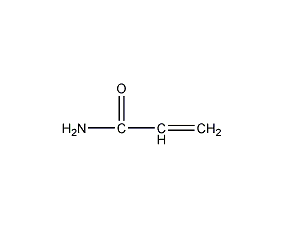
Structural formula
| Business number | 01P7 |
|---|---|
| Molecular formula | C3H5NO |
| Molecular weight | 71.08 |
| label |
Vinylamide, 2-Acrylamide, Vinyl amide, 2-Propenamide, Propenamide, for oil fields, flocculant, soil conditioner, paper strength enhancer, adhesive |
Numbering system
CAS number:79-06-1
MDL number:MFCD00008032
EINECS number:201-173-7
RTECS number:AS3325000
BRN number:605349
PubChem number:24890783
Physical property data
1. Characteristics: white or light yellow crystal, odorless. [1]
2. pH value: 5.0~6.5 (50% aqueous solution) [2]
3. Melting point (℃): 84.5[3]
4. Boiling point (℃): 125 (3.33kPa); 192.6[4]
5. Relative density (water=1): 1.12[5]
6. Relative vapor density (air=1): 2.45[6]
7. Saturated vapor pressure (kPa): 0.21 (84.5℃) [7]
8. Critical pressure (MPa): 5.73 [8]
9. Octanol/water partition coefficient: -0.67[9]
10. Flash point ( ℃): 138 (CC) [10]
11. Ignition temperature (℃): 424[11]
12. Explosion upper limit (%): 20.6[12]
13. Explosion lower limit (%): 2.7[13]
14. Solubility: soluble in water, ethanol, ether, acetone, insoluble in benzene and hexane. [14]
Toxicological data
1. Acute toxicity[15]
LD50: 150~180mg/kg (rat oral)
2. Irritation[16]
Rabbit transdermal: 500mg (24h), mild irritation.
Rabbit eye: 100mg (24h), moderate irritation.
3. Subacute and chronic toxicity [17] After repeated exposure to the poison, almost all animals suffered peripheral nerve damage, manifesting as muscle weakness in the limbs, Severe paralysis of the hind limbs, muscle atrophy of the distal limbs, sensory impairment, and loss of tendon reflexes.
4. Sensitization [18] It has a sensitizing effect on the skin.
Mutagenicity Sister chromatid exchange: Rat oral administration 600mg/kg (10 consecutive days). Sperm morphological changes: mice were injected intraperitoneally with 100 mg/kg.
5. Teratogenicity [19] Female mice were orally exposed to 540mg/kg 6 to 17 days after conception, causing muscle damage in the offspring. Developmental malformations of the skeletal system.
6. Carcinogenicity [20] IARC Carcinogenicity Comment: G2A, possible human carcinogen.
7. Others[21] The lowest oral toxic dose in rats (TDLo): 200mg/kg (gestation 7~16d), causing neonatal ���The use of aqueous solutions is beneficial for labor protection. Product reference specifications: Appearance is white scaly or powdery. The content of first-class products is ≥95%; the content of second-class products is ≥90%; the content of third-class products is ≥85%.


3. Enzyme catalysis method: At room temperature, the aqueous acrylonitrile solution is fed into a fixed bed reactor equipped with a bacterial strain catalyst. The reaction converts 100% acrylonitrile into acrylamide. After separation, industrial products of acrylamide can be obtained without even refining and concentration.
Purpose
1. Prepare polyacrylamide gel and measure protein molecular weight by electrophoresis. Flocculant. Enhance paper strength. Improve fiber quality. Binder.
2. Acrylamide is the most important product among acrylamide and methacrylamide products. After being used in industry in 1954, demand gradually increased. It is mainly used to prepare water-soluble polymers, and this polyacrylamide can be used as an additive to improve the recovery rate of petroleum; it is used as a flocculant, thickening agent and papermaking aid. A small amount of acrylamide is used to introduce a hydrophilic center into a lipophilic polymer to improve the viscosity, increase the softening point and improve the solvent resistance of the resin, and can introduce a center for the color acceptance of the dye. Acrylamide is also often used as a component of photopolymers. In vinyl polymers, the reactivity of this amide group can be used in cross-linking reactions. Acrylamide can be copolymerized with certain monomers, such as vinyl acetate, styrene, vinyl chloride, vinylidene dichloride, acrylonitrile, etc. to obtain polymers with various uses. Main application areas: (1) Oilfield use: This product is used to adjust the water absorption profile of water injection wells in oilfields. Mix this product with initiator, oxygen scavenger, etc., and inject it into the high permeability zone of the water injection well. Polymerizes into high viscosity polymers beneath the earth’s surface. Block large pores, increase oil sweep volume, and improve oil recovery. In addition, the polymer or copolymer of this product can be used for tertiary oil recovery, fracturing, water plugging, drilling mud treatment, chemical grouting, etc. (2) As flocculant, the partial hydrolyzate or graft copolymer with methyl cellulose is used for factory wastewater treatment and sewage treatment. (3) Soil conditioner: The hydrolyzate of this product is used as a soil conditioner to aggregate the soil and improve air circulation, water permeability and water retention. (4) Fiber modification and resin processing Carbamylation or graft polymerization of acrylamide. It can be used to improve the resin finishing of various fibers containing synthetic fibers, warp yarns and as printing and dyeing slurry to improve the basic physical properties of fiber fabrics, anti-wrinkle, anti-shrinkage and good hand feel. (5) Paper strength enhancer: The copolymer of acrylamide and acrylic acid or the partial hydrolyzate of polyacrylamide can be used as a paper strength enhancer to replace or share the already used starch and water-soluble amino resin. (6) Adhesives include fiberglass adhesives used in combination with polyacrylamide and phenolic resin solutions, and pressure-sensitive adhesives used in combination with synthetic rubber.
3. Determination of nucleic acid molecular weight. Dye synthesis. Plastic synthesis. adhesive. Prepare a polyacrylamide gel and determine the protein molecular weight by electrophoresis.
4. One of the important raw materials in the synthetic fiber industry and synthetic materials industry, monomers and their homopolymers and copolymers are increasingly used in national defense construction, petrochemical industry, mineral processing, Papermaking, textiles and water treatment.
5. Used to produce flocculants, dispersants, additives and water-soluble polymers, etc. [29]

 微信扫一扫打赏
微信扫一扫打赏

